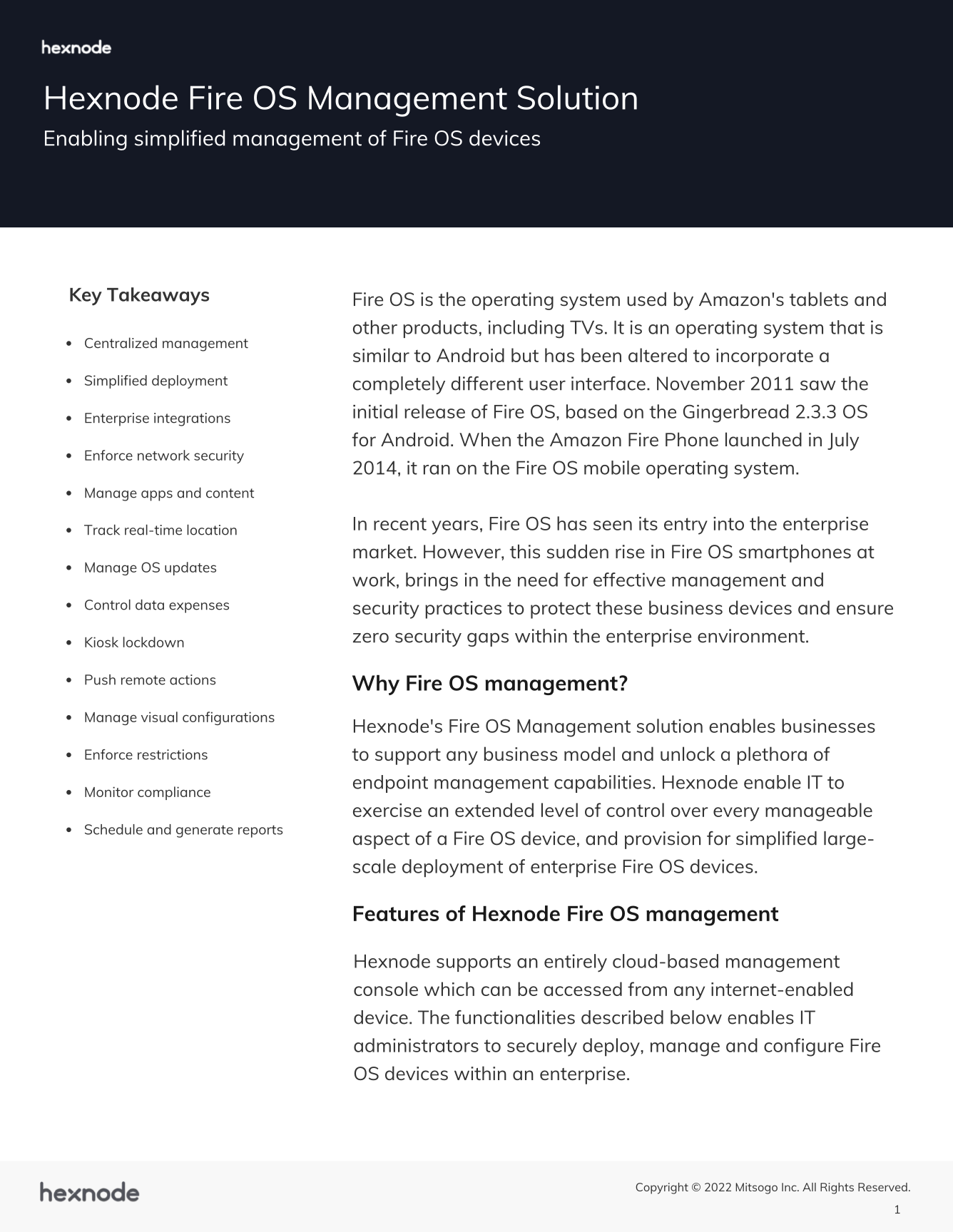An IT manager’s guide to Fire OS management
Let’s have a look at the differences between Android and Fire OS and learn how to manage Fire OS with Hexnode UEM.

Get fresh insights, pro tips, and thought starters–only the best of posts for you.
Aurelia Clark
Sep 11, 2025
12 min read

Ever wondered what it really takes to manage a bunch of Fire OS devices without losing your mind?
You’re not alone.
Amazon’s Fire tablets have become a go-to option in industries like retail, education, and field services, thanks to their affordability, portability, and content-first design.
But while they’re easy to deploy individually, managing dozens or hundreds of them without the right tools quickly becomes a challenge. Unlike traditional Android or iOS ecosystems, Fire OS doesn’t come with out-of-the-box enterprise-grade management features.
Still, with the right setup, Fire OS offers a compelling balance between cost and control, especially for content delivery and kiosk-style use cases.
That’s where the right software services come in. In this blog, we’ll break down the essential Amazon-native and third-party platforms you can use to deploy, secure, and manage your Fire OS device fleet, without the chaos.
Before you can manage apps or enforce policies, Fire OS devices need to be enrolled into your management system. Getting Fire OS devices ready for large-scale use starts with a reliable provisioning method.
Unlike standard Android Enterprise devices, Fire OS doesn’t support Zero-touch enrollment or managed Google Play accounts. This means IT teams need to rely on alternative enrollment flows – usually involving direct access to the device and manual setup. Thankfully, Unified Endpoint Management (UEM) solutions like Hexnode and Amazon’s own tools help bridge this gap.
With no native support for Android Enterprise enrollment, most Fire OS deployments use Amazon Device Management based provisioning. Solutions like Hexnode provide installer agents that can be sideloaded using USB debugging, allowing bulk enrollment and policy application.
For IT teams, this means enabling developer mode, connecting devices via USB, and running automated scripts to complete the setup. While it’s not as seamless as Android Zero-touch, once set up, it’s efficient for enrolling large fleets of Fire tablets (and in some cases, Fire TVs) into a UEM environment with predefined settings and policies.
In education environments, Amazon offers its own Configurator tool to simplify setup and provisioning of classroom tablets. This tool allows admins to bulk-configure Wi-Fi, content filters, and Amazon Kids settings, making it easier to get large groups of devices classroom-ready with minimal manual effort.
While it’s tailored for Fire tablets in schools, similar concepts may be applied in enterprise environments using custom scripts and UEM support.
Managing Fire OS devices isn’t quite the same as managing standard Android or iOS fleets. While Fire OS is built on Android, it’s heavily customized by Amazon and that means traditional Android Enterprise tools may not always work out of the box. That said, there are several core services and workarounds IT teams can use to streamline provisioning, app deployment, and policy enforcement.
Amazon’s own device management tool is designed specifically for Fire tablets used in classrooms, offices, and shared device environments. ADM provides basic yet crucial controls for bulk provisioning and configuration.
With features like remote device lockdown, Wi-Fi setup, and app deployment, it’s a straightforward solution for educational institutions and small-to-mid-sized businesses that primarily rely on Amazon’s tablet ecosystem.
For organizations developing apps specifically for Fire OS, AWS Device Farm offers a powerful cloud-based testing environment. It lets QA teams remotely test apps on a wide range of physical Fire tablets and selected Fire TVs—without needing to maintain their own device labs.
This is especially helpful for ensuring performance and compatibility across Fire OS versions before pushing apps live on the Amazon Appstore.
Even though Fire OS doesn’t fully support Android Enterprise, its Android base still allows for limited integration with Android management tools. Some UEM platforms, like Hexnode use ADB-based enrollment methods and proprietary agents to enable device management on Fire OS.
While Fire OS doesn’t support Android Management APIs directly, these platforms offer comparable functionality such as remote actions, app control, and kiosk enforcement through custom integrations.

Hexnode’s Fire OS Management solution enables businesses to exercise an extended level of control over every manageable aspect of a Fire OS device, and provision for simplified large-scale deployment of enterprise Fire OS devices.
Download the datasheet Fire OS app and content management
Fire OS app and content management
The Amazon Appstore serves as the default app marketplace for Fire OS devices. For organizations, the Appstore for Business allows curated app distribution—similar to private app publishing in Google Play.
Key benefits include:
This makes it especially useful for productivity apps, educational tools, or custom software across managed Fire tablets and supported Fire TV models.
For teams building content-heavy apps—especially for streaming, signage, or educational media—Fire App Builder offers a customizable Android-based framework.
It enables fast development of branded apps with minimal coding, making it ideal for:
Fire App Builder works across both Fire tablets and Fire TV devices, supporting consistent app behavior in locked-down or kiosk-based environments.
Not every business app needs to be native. Many organizations use web apps hosted internally or in the cloud, which are then sideloaded into Fire OS devices using custom browser wrappers or kiosk configurations.
Why use this approach?
This method is especially common in frontline or educational deployments, where flexibility and ease of updates are critical.
When deploying Fire OS devices in education, frontline, or customer-facing roles, ensuring safe and controlled access to web content becomes just as important as managing apps. While Fire OS isn’t built with enterprise-grade content filtering out of the box, there are a few reliable options to lock down browsers and restrict usage to approved sites or apps.
This becomes especially important in classroom setups or retail kiosks, where users should only access specific training portals, product catalogs, or approved educational resources.
Originally intended for home use, Amazon Kids includes robust parental controls that can be repurposed in education or training environments. With this, administrators can:
Though it’s not a full substitute for enterprise web filtering, it offers a practical workaround for basic content control, especially in classrooms using Fire tablets.
For more controlled environments, especially in kiosk deployments, UEMs like Hexnode allow IT teams to enforce browser lockdowns.
This can include:
These configurations are commonly used in public kiosks, digital forms, or internal dashboards, ensuring users only interact with content that’s been vetted and approved.
When deploying Fire OS devices in education, frontline, or customer-facing roles, ensuring safe and controlled access to web content becomes just as important as managing apps. While Fire OS isn’t built with enterprise-grade content filtering out of the box, there are a few reliable options to lock down browsers and restrict usage to approved sites or apps.
 Fire OS kiosk and lockdown utilities
Fire OS kiosk and lockdown utilities
Select Fire OS devices support Amazon’s native kiosk mode APIs, which let IT admins lock a device into single-app or multi-app mode. This is especially useful for retail checkouts, front-desk displays, or interactive catalogs, where devices must stay focused on a specific task.
For example, Fire TV devices in hotel lobbies or waiting areas can be configured for media-only access using custom launchers.
For more advanced control, UEM platforms like Hexnode offer ADB-based kiosk enforcement. By sideloading the Hexnode agent and enabling device owner mode, IT admins can configure Fire OS devices to:
This is particularly valuable in large-scale enterprise rollouts, where manual setup isn’t feasible and centralized control is critical. Fire tablets see the strongest support here, though certain Fire TV use cases—like unattended media displays—can benefit from basic lockdown configurations as well.
After deployment, keeping Fire OS devices running smoothly—and securely—requires ongoing visibility and control. Especially in distributed setups, IT teams need tools that enable them to troubleshoot issues, apply updates, and enforce policies without having physical access to the devices. Fire OS doesn’t offer native enterprise support for remote control, but UEM platforms help bridge that gap using Android-compatible workarounds.
Hexnode UEM offer remote support features through ADB-based integration with Fire OS. This allows IT admins to:
This kind of remote control is especially useful for kiosks, field devices, or classrooms where in-person support isn’t feasible
Keeping devices up to date is key to ensuring performance and security. While Fire OS updates are generally managed via the device’s system settings, there is no native support for enterprise-grade OTA scheduling or staged rollouts—a feature commonly found in Android Enterprise or iOS ecosystems.
UEMs like Hexnode help bridge this gap by allowing IT teams to coordinate updates using scripts, push alerts, or compliance-based triggers. In some setups, admins use version-specific profiles to identify outdated devices and initiate remediation workflows, ensuring the fleet stays current even without direct user interaction.
Despite being primarily tailored for consumer use, Fire OS can be molded into a manageable enterprise platform with the right supporting stack. By combining Amazon’s native capabilities with the advanced control of UEM platforms like Hexnode, organizations can manage apps, enforce policies, and support devices efficiently—without the usual limitations.
It’s this layered strategy that makes all the difference: leveraging Amazon for foundational setup, and a UEM for deep visibility and enforcement.
With the right approach, Fire OS evolves from a consumer-first OS into an enterprise-grade solution built for scale.
Sign up for a free trial and explore Hexnode Fire OS management features.
Sign Up now!